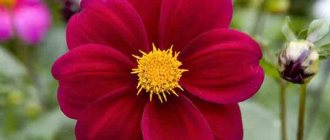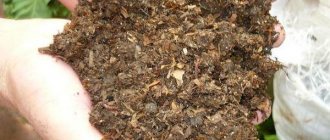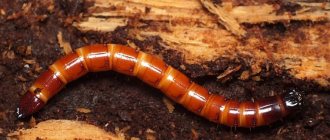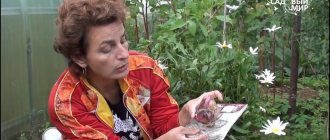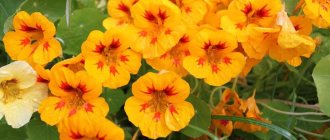For most people, roses remain their favorite flowers, despite their sharp thorns and capriciousness in care.
To achieve a truly gorgeous rose garden on your site, you need to properly fertilize roses. Important! The main element that roses need is phosphorus.
It is this that promotes the formation of new roots, and also affects the size of the buds and their number. In addition to phosphorus, potassium and nitrogen are also needed for lush flowering . As for the seasonality of fertilizer application, phosphorus can be used all the time, while plants will need nitrogen only in the spring, since it is a growth stimulant for bushes.
In addition, you need to know the limit in this fertilizer, since if it is in excess, the flowering of the bush will be delayed to a later date, and the likelihood of various diseases will increase.
And we should also not forget about such useful substances as magnesium, iron, boron and manganese . Each of them has a beneficial effect on growth and flowering.
Fertilizers for roses when planting
Loamy soil is considered ideal for planting roses because it retains moisture well. It is necessary to dig a hole that will be approximately fifty centimeters deep and about one meter wide.
To prevent liquid from stagnating in the hole, broken brick or crushed stone should be placed at its bottom. Sprinkle soil with superphosphate on top.
When planting in spring, you can only use special fertilizer, for example, Gera fertilizer; other types are better after the plant has established itself.
If there is no commercial fertilizer available, you can make it yourself: mix 1 tablespoon of superphosphate, 1.5 kg of humus and 30 g of ash. This is a recipe for planting one rose bush.
Disease and pest control
To prevent diseases and pests, it is recommended to turn to folk remedies. For example, next to roses you can plant crops with a pronounced smell - marigolds, onions or sage. You can also treat roses with wood ash or use an infusion from a collection of plants: onions, yarrow, garlic and calendula.
To prevent powdery mildew, spider mites, aphids and rust, roses and soil are sprayed with the following solution:
- 100 g copper sulfate 3%;
- a bucket of water.
Organic fertilizers for roses
Of the organic ones, only fertilizing with fresh manure is prohibited, as it can burn the roots of roses . All other useful substances are welcome.
Peat or vegetable compost is periodically poured under the roses. The remaining fertilizers are applied along with water in the correct proportions.
If you want to fertilize with fresh chicken droppings, then you should dilute it 1:20 with liquid, if old, then 1:10.
Before use, this organic fertilizer must be left in a dark place for five days and then diluted with water in a ratio of 1:3.
Important! Gardeners often use regular yeast to stimulate the growth of roses.
You can also use cow infusion, which must first be diluted 1:10 and after it has stood in a dark place for about a week, diluted with water in equal proportions.
Fertilizing roses with manure is most often used, however, if this is not at hand, you can use weed grass . To do this, its leaves and stems are crushed very finely, compacted well, and covered with water. Leave the fertilizer in a dark place for 10 days, dilute it with water 1:10, and water the bushes.
For higher efficiency of the above solutions, you can dilute superphosphate or wood ash in 50 liters of water.
A good option as a fertilizer for roses is coffee or blood meal . Such products contain many microelements necessary for flowers; they contribute to the good development and flowering of bushes.
How to properly feed plants
Florists use two types of fertilizers; root fertilizers involve introducing active substances into the soil, from where they are absorbed by the roots. Fertilizing can include preparations produced in liquid or solid form; the latter are pre-dissolved in water or directly in the soil. To do this, dig a ring groove at a distance of 15-20 cm from the trunk; its depth should be shallow, otherwise there is a risk of damaging the root shoots.
The drug is applied into the furrow and covered with soil, or else, the dose of the drug required for the plant is laid out along the root circle, and then thoroughly loosened, embedding the powder or granules into the soil. Both options ensure a gradual supply of the shrub with the necessary microelements.
Top dressing can be foliar; the advantage of this technique is that beneficial microelements are absorbed faster, but the composition of the soil mixture does not change. Therefore, despite the undoubted effect of foliar feeding, it will not replace root feeding. However, it can be carried out as a single application.
There are a number of peculiarities when foliar feeding; it cannot be carried out on sunny days, since in such weather it is easy to cause burns of leaves and stems. Choose early morning or evening for procedures, when the sun's rays are not yet active enough. It is not recommended to treat shrubs during rain, late evening and on days with high humidity. Excess moisture can lead to fungal diseases. Special requirements are also imposed on solutions for foliar feeding; they must be less concentrated than with the root method. Usually the concentration of the working solution is halved, but this may not be the case, so it is important to follow the manufacturer's instructions on the packaging. Otherwise, there is a high risk of burning the leaves and stems.
Mineral fertilizers for roses
This type of fertilizing is as necessary for the growth and development of roses as organic fertilizers. Nitrate and urea are nitrogen fertilizers that affect the formation of shoots and leaves.
Superphosphate and ammophos are phosphorus, they affect luxurious flowering.
Potassium fertilizers help bushes survive severe frosts in winter, and also help retain moisture on the leaves and stems.
Of this group, potassium sulfate is considered the best substance; this drug is universal.
A good option is Fertika (Kemira) or Green Boom.
Foliar feeding of roses
Such fertilizers are additional to the main root fertilizers; they can be used all year round, except winter, regardless of the name of the flowers. Fertilizer penetrates the plant through leaves and stems.
The main condition is that it is used only in clear, dry weather, and the liquid fertilizer must be freshly prepared.
With this method of fertilization, both organic and mineral compounds are diluted with water in a proportion twice as large as when feeding at the root.
The Gloria fertilizer has proven itself well in this regard.
Basic processing rules
For better absorption of nutrients, fertilizers are alternated. The ideal option is to use organic and mineral supplements alternately to obtain lush flowering and active growth.
Root fertilizers are applied as follows:
- a ditch is dug around the bush;
- The grooves are watered generously at the rate of 10 liters of water per 1 square meter. m;
- apply fertilizer;
- loosen the soil and level it;
- If possible, add mulch.
Thanks to regular care and properly selected compositions, roses will actively develop and delight with lush, long-term flowering. In addition to fertilizers, bushes need regular watering, getting rid of weeds, and loosening the soil. An integrated approach will give excellent results.
Fertilizing indoor roses
Indoor plants are the most whimsical, so you need to be very careful with them. In these flowers, both roots and leaves need to be fertilized.
Moreover, in the spring, when intensive plant growth begins, they need nitrogen and potassium most of all. You can use both purchased ones and prepared ones yourself from litter and manure. For indoor roses, Fasco fertilizer is a good option.
Fertilizer calendar, when to start and how to finish
Spring is the best time to properly fertilize your plants . As for the frequency of feeding, they should be carried out approximately once every two to three weeks.
The first fertilizers should be applied after the first pruning of the bushes, when the buds begin to open. It is recommended to feed the second time when the leaves begin to appear.
The third time is when the buds begin to open. No later than mid-September, the last feeding of roses for the season should be done.
By following these simple rules when applying fertilizer, your roses will always delight you with lush and long flowering.
What do roses need in spring and summer?
During this period, active growth begins, so in spring and summer it is simply impossible to do without applying fertilizers. The first feeding should be carried out in the spring after pruning.
The best fertilizer for roses in the warm season is this: dissolve fifty grams of superphosphate and ammonium nitrate in a bucket of water and spray the bushes. You can also purchase the drug Pocon.
Important! Pokon is a universal remedy. You can feed the bushes once and forget about fertilizers for a whole year.
You can also use humus; for this, manure with complex fertilizer is placed near the shoots. The second feeding begins around May. It is best to use ten grams of nitrogen, the same amount of potassium salt and twenty grams. superphosphate.
At the beginning of summer, when buds already appear on the plants, they carry out another fertilizing with the same composition that was used in the spring.
Important! When the buds have bloomed for the first time, you can spray them again with the above fertilizers. Or use garden compost; one shovel is enough for one bush.
At the end of summer, it is advisable to add twenty grams of potassium salt and forty grams. superphosphate. Ash infused with water is most often used between feedings in the form of spraying bushes.
To prepare it, you need to take one hundred grams of ash and add hot water (about two liters). Leave in a dark place for a day, then drain the infusion from above and increase the volume to five liters.
In this video, the expert talks in detail about how and what to feed a rose when planting, in spring and summer during flowering:
Autumn feeding of roses
Of course, the plant must be properly prepared for winter so that it can withstand severe frosts. The first time roses are fertilized at the end of summer, and the second time at the end of September.
At this time of year, it is necessary to stop using nitrogen substances so as not to stimulate plant growth. In addition, it is not recommended to add manure before winter, as this will force the plant to produce new shoots, which will take away excess strength from the flowers.
Important! All rose bushes need before dormancy is phosphorus, calcium and potassium.
How to plant roses in the garden in spring: features, requirements and step-by-step instructions
Planting site (location on the site) As the experience of practicing gardeners confirms, a place for planting roses should be chosen that is quiet and calm, not shaded from the sun, but sheltered from the wind. That is why you should abandon the idea that the location of a bush surrounded by trees, right next to a wall or near any building, is comfortable for a rose.
However, for example, climbing varieties of roses know how to manage the northwestern areas of the garden allotted to them: they grow and bloom well in shady places.
What kind of soil is needed Roses like to grow in slightly acidic soil (pH 5.5-6.5), therefore, if the soil is highly acidic, you cannot immediately plant roses in your summer cottage; you must first reduce its acidity.
When preparing the soil for planting roses in the spring, it will also be great if you add rotted manure (humus) or compost, as well as wood ash (as a potassium-phosphorus fertilizer) into it.
At what depth to plant (preparing the planting hole for planting) As a rule, the width of the planting hole is on average 50 cm. However, the depth varies, and the type of soil is to blame for this. In the case of using loamy soil, the depth of the hole is drawn as follows: 15 cm is added to the length of the roots. But, say, with heavy, damp clay soil containing about 35-45% pure clay, the hole is planned to be deeper (60-70 cm). In this case, it would be a good idea to add compost (you can also use humus mixed with 1-2 cups of ash), and it is advisable to pour a pile of fertile soil on top.
Step-by-step guide to direct planting Here are the steps you will need to take:
Dip the roots of previously prepared rose seedlings into a clay solution (do not forget to add fertilizer to it (dissolve 6 phosphobacterin tablets in 1 liter of water and add 10 liters of mash), then place the seedlings on a hill, not forgetting to tidy up the roots. Fill the hole with soil seedling, deepen the grafting site by 4-7 cm (depending on the variety, see above).To simply and reliably protect the root collar from temperature fluctuations, you need to compact the soil around the seedling.
Water the seedling generously with the same solution that remained after soaking it (or just water), being careful not to touch the shoots to eliminate the risk of sunburn. If the watering turns out to be too abundant and the place of grafting of the seedling appears, it is necessary (this must be done) to sprinkle it with earth.
Having finished planting roses, you need to move on to pruning, leaving at least 2 buds on each shoot. It is recommended that they be treated with garden varnish or a similar product purchased at a specialized store. It is quite reasonable to do this in the spring, since in the fall the young shoots most likely will not survive and will freeze. The final manipulation in the process of spring planting a rose should be its mulching. For this purpose, it would be a good idea to use compost, humus or dry soil.

